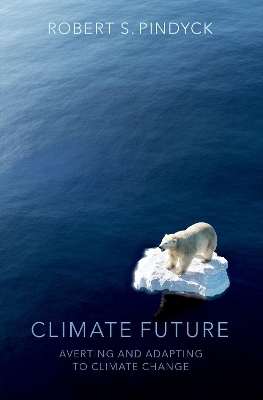
Climate Future
Oxford University Press Inc (Verlag)
978-0-19-764734-9 (ISBN)
Most people would probably agree on what should be done to avert severe climate change: The world must reduce CO2 emissions as much and as quickly as possible. But we must also ask what will be done. Is it realistic to expect worldwide emissions to fall rapidly enough to prevent severe climate change? And if we conclude it is not realistic, and so higher temperatures and rising sea levels are likely, what should we do? What actions should we take now to reduce the likely impact of climate change?
Whatever climate policies are adopted, there will be a great deal of uncertainty over what will happen as a result. In Climate Future, Robert Pindyck, an authority on the economics of climate change and global catastrophes, explains what we know and what we don't know about the extent of climate change and its impact, why there is so much uncertainty, and what it means for climate policy. This book shows that given the economic and political realities, it is simply not realistic to expect emission reductions needed to avert substantial global warming. Pindyck argues that investments in adaptation-developing new hybrid crops, discouraging building in flood-prone or wildfire-prone areas, building sea walls and dikes, and geoengineering-are needed to insure against catastrophic climate change events. We should invest now in adaptation, and Pindyck shows how that can be done.
Robert S. Pindyck is the Bank of Tokyo-Mitsubishi Professor of Economics and Finance in the Sloan School of Management at MIT. He is also a Research Associate of the National Bureau of Economic Research, and he has been a Visiting Professor at Tel-Aviv University, Harvard University, and Columbia University. He is a Fellow of the Econometric Society, a past President and Fellow of the Association of Environmental and Resource Economists, and a winner of the Jamieson Prize for Excellence in Teaching. Professor Pindyck's research and writing have covered topics in microeconomics and industrial organization, the behavior of natural resource and commodity markets, financial markets, capital investment decisions, and environmental economics. His recent work in environmental economics has focused on climate change, and examined policy design in the face of uncertainty. He has also worked on the economic and policy implications of global catastrophic events, including the COVID-19 pandemic. Professor Pindyck has published numerous academic journal articles, and he is also the author or co-author of seven books, including three popular textbooks: Econometric Models and Economic Forecasts, Microeconomics, and Investment Under Uncertainty.
INTRODUCTION
1.1 Averting and Adapting: The Basic Argument
1.2 What Is Adaptation?
1.2.1 Concerns about Adaptation
1.2.2 Carbon Removal and Sequestration
1.3 What Comes Next
1.4 Further Readings
CHAPTER 2: THE FUNDAMENTAL PROBLEM
2.1 A Few Facts and Numbers
2.2 An Optimistic Scenario
2.3 The Bottom Line
2.4 Further Readings
CHAPTER 3: WHAT WE KNOWAND DON'T KNOWABOUT CLIMATE CHANGE
3.1 The Social Cost of Carbon
3.2 Climate Change Basics
3.3 What We Know (or Sort of Know)
3.3.1 What Drives CO2 Emissions?
3.3.2 What Drives the Atmospheric CO2 Concentration?
3.4 What We Don't Know
3.4.1 Climate Sensitivity
3.4.2 The Impact of Climate Change
3.4.3 A Catastrophic Outcome
3.5 Further Readings
CHAPTER 4: THE ROLE OF UNCERTAINTY IN CLIMATE POLICY
4.1 Implications of Uncertainty
4.1.1 The Treatment of Uncertainty
4.1.2 How Does Uncertainty Affect Climate Policy?
4.1.3 The Value of Climate Insurance
4.1.4 The Effects of Irreversibilities
4.2 Further Readings
4.3 Appendix to Chapter 4: Effects of Irreversibilities
CHAPTER 5: CLIMATE POLICY AND CLIMATE CHANGE: WHAT CAN WE EXPECT?
5.1 CO2 Emission Reductions
5.1.1 The United States
5.1.2 The U.K. and Europe
5.1.3 China
5.1.4 The Global Picture
5.2 CO2, Methane, and Temperature Change
5.2.1 The Warming Effect of CO2 Emissions
5.2.2 Methane Emissions
5.2.3 The Warming Effect of Methane Emissions
5.3 Temperature Change Scenarios
5.3.1 Changes in Temperature
5.3.2 Implications of Uncertainty
5.4 Rising Sea Levels
5.5 Summary
5.6 Further Readings
5.7 Appendix to Chapter 5: Temperature Scenarios
CHAPTER 6: WHAT TO DO: REDUCING NET EMISSIONS
6.1 How to Reduce Emissions
6.1.1 A Carbon Price
6.1.2 Government Subsidies
6.1.3 Government Mandates
6.1.4 Cap-and-Trade
6.1.5 How Large a Carbon Tax?
6.1.6 An International Agreement
6.1.7 Research & Development
6.2 Nuclear Power
6.3 Removing Carbon
6.3.1 Trees, Forests, and CO2
6.3.2 Carbon Removal and Sequestration
6.3.3 The Bottom Line
6.4 Further Readings
CHAPTER 7: WHAT TO DO: ADAPTATION
7.1 Adaptation in Agriculture
7.1.1 What Can the Data Tell Us?
7.1.2 An Historical Experiment
7.1.3 What To Expect?
7.2 Hurricanes, Storms, and Rising Sea Levels
7.2.1 Flooding and Its Impact
7.2.2 Physical Barriers to Flooding
7.2.3 Natural Barriers to Flooding
7.2.4 Private and Public/Private Adaptation
7.2.5 Flood Insurance
7.2.6 Flood Risk in Asia
7.2.7 What to Expect?
7.3 Solar Geoengineering
7.3.1 How It Would Work
7.3.2 How Much Would It Cost?
7.3.3 Problems with Solar Geoengineering
7.3.4 What to Do?
7.4 Can Adaptation Solve Our Climate Problem?
7.5 Climate Future
7.6 Further Readings
Bibliography
| Erscheinungsdatum | 04.07.2022 |
|---|---|
| Zusatzinfo | 40 b&w illustrations |
| Verlagsort | New York |
| Sprache | englisch |
| Maße | 164 x 238 mm |
| Gewicht | 544 g |
| Themenwelt | Naturwissenschaften ► Biologie ► Ökologie / Naturschutz |
| Sozialwissenschaften ► Politik / Verwaltung ► Politische Theorie | |
| Wirtschaft ► Volkswirtschaftslehre | |
| ISBN-10 | 0-19-764734-0 / 0197647340 |
| ISBN-13 | 978-0-19-764734-9 / 9780197647349 |
| Zustand | Neuware |
| Haben Sie eine Frage zum Produkt? |
aus dem Bereich


